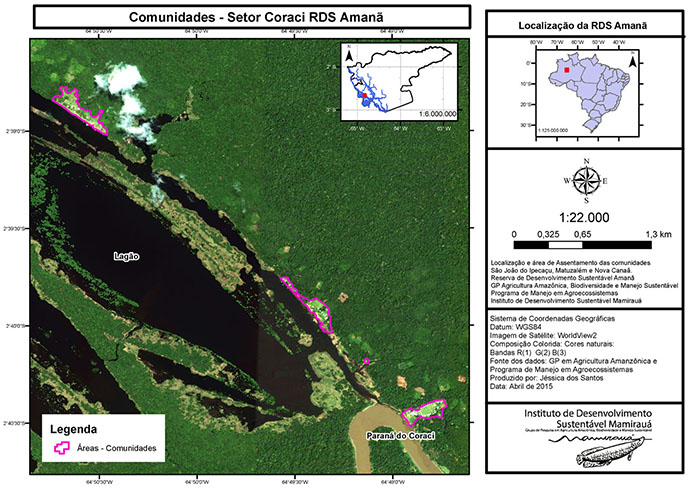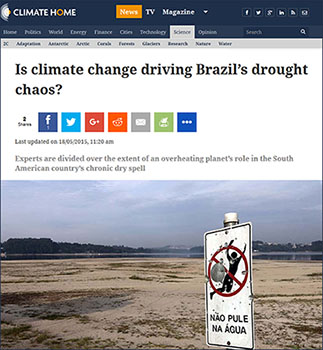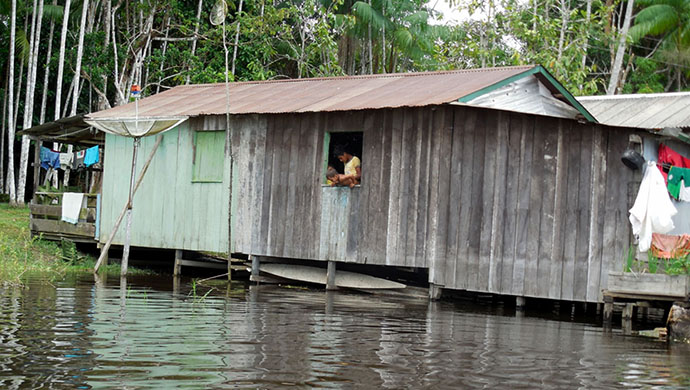Introduction
 Our Research Highlight is authored by Dr. Sam Schramski. Sam was affiliated with CSTPR and the Center for Environmental Journalism in 2015 and 2016. He is a visiting postdoctoral scholar from the Federal University of Amazonas in Manaus, Brazil, and is based out of the Graduate Program in Amazonian Society and Culture. He has a Ph.D. in Interdisciplinary Ecology from the University of Florida. Sam has research interests in local and community-level climate change adaptation in the developing world, particularly in the Brazilian Amazon and southern Africa. He spent 2014 working on a field project that included perceptions of climate change amongst riverine populations living in Amazonian flooded forests. Sam is also a freelance journalist, having produced radio stories for NPR and Radio France International, and written blog posts for Brasil Post, Brazil’s Huffington Post affiliate. Our Research Highlight is authored by Dr. Sam Schramski. Sam was affiliated with CSTPR and the Center for Environmental Journalism in 2015 and 2016. He is a visiting postdoctoral scholar from the Federal University of Amazonas in Manaus, Brazil, and is based out of the Graduate Program in Amazonian Society and Culture. He has a Ph.D. in Interdisciplinary Ecology from the University of Florida. Sam has research interests in local and community-level climate change adaptation in the developing world, particularly in the Brazilian Amazon and southern Africa. He spent 2014 working on a field project that included perceptions of climate change amongst riverine populations living in Amazonian flooded forests. Sam is also a freelance journalist, having produced radio stories for NPR and Radio France International, and written blog posts for Brasil Post, Brazil’s Huffington Post affiliate.
|
Climate Change in an Amazon Town:
Media and Environmental Perceptions in Ever-Rising Waters
by Sam Schramski
In December I presented findings on my work on climate change perceptions within rural communities in the Brazilian Amazon. The research was preliminary and I hope it builds into further fieldwork in the not-too-distant future. My focus was on the relationship between the role of news media as a national purveyor of information in the context of limited regional media outlets and the lived experiences of individuals with whom I worked in the Mamirauá Reserve. The latter was primarily collected via interviews, especially with the elderly.
I began the presentation discussing media theory and the idea of cross-cultural interpretations of environmental changes mediated by television and, to a lesser extent, radio and the Internet. The key feature of the presentation was what I perceive to be an interesting feature of life in a dynamic ecological settings like Amazonian floodplain forests, where changes are constant and dramatic and media and policy formulations of what climate change has wrought (and will continue to wreak) don’t necessarily reflect this. I also highlighted what I feel are the important disjunctures between received media and public policy in settings very foreign to those displayed on TV in Brazil, where programming is not regional. The effect is that very little news content from areas in the vast North of the country are ever seen. |

Map of the Mamiruá Reserve. The communities where I worked are highlighted in fuchsia. The várzea, or flooded forest ecosystem, is highly dynamic and is characterized by numerous lakes and other features that vary depending on the flooding regime (credit: Jéssica dos Santos, Instituto Mamirauá). |
It’s important to note that local riverine people in the places I have worked in the Amazon often discuss the causes and effects of climate change in very different ways than one might imagine: the droughts in São Paulo seem a world away, yet in the Central Amazon they are more commonly discussed than the changing water levels of the river and its numerous tributaries and lakes. This is perhaps problematized by the fact that the projected effects of climate change continue to be proteiform throughout the basin, from alterations to the evapotranspiration cycle, to significant losses of biodiversity, to of course riverine flux.
While exploratory, my initial results indicate that for other contexts, say in Boulder, Colorado as an example, we tend to discuss variability and uncertainty but often have difficulty imagining a situation in which our livelihoods would be altered so dramatically within a given year, every year. This point is critical for environmental social scientists to consider, especially as we explore issues of adaptation in rural and urban environments. Secondly, media and policy formulated from afar, even if seemingly well-intentioned, often do not comport with the lived experiences of people in places like the rural Brazilian Amazon. This has serious consequences for how scientists, policymakers, and the media craft messages, especially if they assume their audience has some shared notion of the phenomenon in question (not just, but including climate change itself). |

Media coverage of the ongoing Brazilian drought. Zika virus may be garnering all the headlines in Brazil these days, but the massive drought in southeastern Brazil saturated the national airwaves for months. For many in the rural Amazon, droughts like these are how climate change is portrayed via media and policymakers (credit: The Guardian). |
This disconnect could be harmless, but it could also pose challenges to effective delivery of information and prescriptions. In this way, small rural communities in the middle of the world’s largest tropical forest ecosystem may have more to reveal about more generalizable features of the nexus of policy, media, and biophysical science than may initially presume.
Sam Schramski
sam.schramski@colorado.edu |


 Our Research Highlight is authored by Dr. Sam Schramski. Sam was affiliated with CSTPR and the Center for Environmental Journalism in 2015 and 2016. He is a visiting postdoctoral scholar from the Federal University of Amazonas in Manaus, Brazil, and is based out of the Graduate Program in Amazonian Society and Culture. He has a Ph.D. in Interdisciplinary Ecology from the University of Florida. Sam has research interests in local and community-level climate change adaptation in the developing world, particularly in the Brazilian Amazon and southern Africa. He spent 2014 working on a field project that included perceptions of climate change amongst riverine populations living in Amazonian flooded forests. Sam is also a freelance journalist, having produced radio stories for NPR and Radio France International, and written blog posts for Brasil Post, Brazil’s Huffington Post affiliate.
Our Research Highlight is authored by Dr. Sam Schramski. Sam was affiliated with CSTPR and the Center for Environmental Journalism in 2015 and 2016. He is a visiting postdoctoral scholar from the Federal University of Amazonas in Manaus, Brazil, and is based out of the Graduate Program in Amazonian Society and Culture. He has a Ph.D. in Interdisciplinary Ecology from the University of Florida. Sam has research interests in local and community-level climate change adaptation in the developing world, particularly in the Brazilian Amazon and southern Africa. He spent 2014 working on a field project that included perceptions of climate change amongst riverine populations living in Amazonian flooded forests. Sam is also a freelance journalist, having produced radio stories for NPR and Radio France International, and written blog posts for Brasil Post, Brazil’s Huffington Post affiliate.

